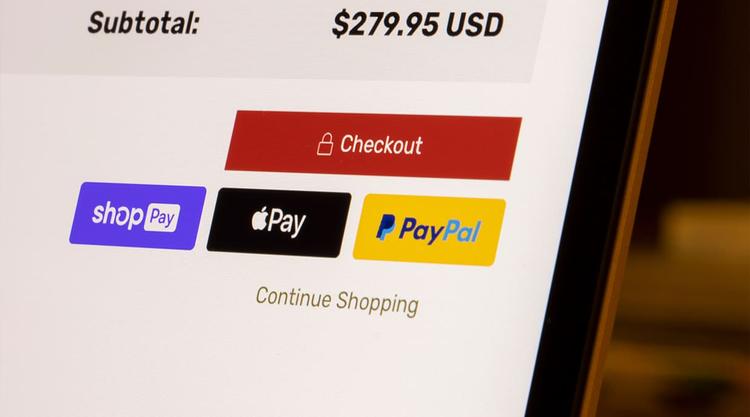Checkout Component – Shopify’s Newest Composable Component is Here
Sector: Digital Commerce
Author: Nisarg Mehta
Date Published: 03/14/2023

Contents
The trend toward modular and microservices architecture in software development is driving the trend for composable commerce components.
What are Composable Commerce Components?
Composable commerce components are modular, reusable pieces of code that can be combined to build an eCommerce website or application. These components can include things like product listings, shopping carts, and checkout forms.
An example of a composable commerce component would be a “product card” component that displays information about a specific product, such as its name, price, and image. This component could be used in multiple places throughout an eCommerce website, such as on a category page or search results page, without needing to be rewritten each time.
Composable components provide a way to simplify the development process of eCommerce websites and applications. The ability to reuse components across the website makes it more time-efficient and cost-effective for eCommerce developers to build and maintain the website.
Additionally, the modular nature of components allows for easy updates and maintenance, as changes can be made to individual components rather than the entire website.
The use of components also promotes consistency and improves the user experience by ensuring that UI elements are consistent across the website.
Shopify’s Checkout Component
Well, Shopify’s new composable component is here – the Checkout Component.
The component aims to bring a powerful new way to build and manage eCommerce websites. This new component makes designing and customizing an entire checkout experience easier for business owners and developers alike.
With its modular architecture, Checkout Component allows for an unprecedented level of customization, providing a fully customizable checkout experience that is tailored to eCommerce businesses’ individual needs.
Shopify says that this component reduces the checkout time by 75%.
Furthermore, the component is highly extensible, allowing developers to add custom features and functionalities to the checkout process easier. In fact, eCommerce experts at Techtic believe that with this new component, Shopify has taken eCommerce to the next level and made the checkout process easier and faster than ever before.
Shopify’s checkout component uses HTML, CSS, and JavaScript for customizing the checkout pages and for custom checkout scripts. It uses the Liquid template engine to enable merchants to customize their checkout pages.
Some of the highlights of Shopify’s checkout component include the following:
- Customizable design: Merchants can use Shopify’s theme editor to customize the look and feel of their checkout pages to match their brand.
- Secure payment processing: Shopify offers support for a wide range of payment gateways, including major credit cards, PayPal, and Apple Pay. All transactions are processed through Shopify’s secure servers.
- Automatic taxes and shipping rates: Shopify can automatically calculate taxes and shipping rates based on the customer’s location, weight, and dimensions of the products.
- Multilingual support: Shopify’s checkout component supports multiple languages, allowing merchants to reach global customers.
- Responsive design: The checkout pages are optimized for mobile devices and adjust their layout automatically to the screen size.
- Customizable checkout fields: Merchants can add or remove checkout fields as per their requirements, such as asking for customers’ phone numbers or adding a custom field for gift wrapping.
- Customizable checkout scripts: Shopify allows merchants to use custom JavaScript to customize the checkout experience.
- Abandoned checkout recovery: Shopify provides email notifications and recovery options for customers who abandoned their shopping carts, allowing merchants to recover lost sales.
Other Useful Shopify Composable Commerce Components
Shopify offers several other composable commerce components that eCommerce developers can use. Here are these:
Storefront
Shopify’s Storefront component allows eCommerce developers to create a customized and dynamic front-end experience in online stores. It is built on top of GraphQL and provides a flexible and powerful API for developers to retrieve and manipulate the online store data. Some of the benefits of Shopify’s Storefront component for eCommerce developers include:
- Customizable design: Developers can use Shopify’s theme editor to customize the look and feel of their storefront pages to match their brand, including the use of Liquid, Shopify’s templating language, to add dynamic logic to the pages.
- Headless API: The commerce component allows eCommerce developers to create unique CX for any platform, including web and mobile apps, AR/VR, and even 3D models.
- Dynamic product and collection pages: Shopify’s Storefront component allows developers to easily create product and collection pages that automatically update with new products and inventory levels using GraphQL to query and retrieve the data.
- Efficient product search: The Storefront component includes an efficient product search feature that allows customers to find what they’re looking for quickly. It’s built on top of Algolia, which is a powerful search engine; developers can customize it and also add additional features like autocomplete.
- Multi-language support: Shopify’s Storefront component supports multiple languages, allowing developers to reach global customers. It can be achieved by creating translations for specific fields in the GraphQL schema.
- Responsive design: The storefront pages are optimized for mobile devices and adjust their layout automatically to the screen size, using CSS media queries and Flexbox.
- Customizable page templates: Developers can create custom page templates for specific store sections, such as the homepage or product pages, using a template engine like Liquid.
- Customizable navigation: Shopify’s Storefront component allows developers to customize the navigation of their store, including the main menu and footer links, by querying the store navigation data through GraphQL.
Core Commerce
Shopify’s Core Commerce component allows eCommerce developers to manage the core functionality of their online store, such as products, orders, and customers.
Here are highlights of the Core Commerce component:
- Product management: Developers can use Shopify’s Core Commerce component to easily manage products, including creating, updating, and deleting products, as well as managing product variants, options and images. All of this can be done through GraphQL API.
- Order management: Developers can use Shopify’s Core Commerce component to manage orders, including creating, updating, and deleting orders, as well as managing order fulfillment, shipping, and payments.
- Customer management: Developers can use Shopify’s Core Commerce component to manage customers, including creating, updating, and deleting customers, as well as managing customer accounts and order history.
- Inventory management: Developers can use Shopify’s Core Commerce component to manage inventory, including tracking inventory levels and creating low stock notifications.
- Tax and shipping management: Developers can use Shopify’s Core Commerce component to manage taxes and shipping, including calculating shipping rates, creating shipping zones, and calculating taxes based on location.
- Reporting and analytics: Developers can use Shopify’s Core Commerce component to access detailed reporting and analytics, including sales data, customer data, and inventory data.
Data and Compliance
Shopify’s Data and Compliance component empower eCommerce developers to manage and comply with various data regulations and requirements, such as GDPR and CCPA. It provides developers with the necessary tools to manage data privacy and compliance for their online store effectively.
- Data privacy and security: Developers can manage data privacy and security, including creating and managing privacy policies, data processing agreements, and deletion requests. This component complies with SOC 2.
- Data analysis: Developers can obtain business intelligence through ShopifyQL, Shopify’s query language designed specifically for trading. They can even move the data into an individual data repository.
- Card data and vaulting: They can use Shopify’s vault or even integrate their existing solution to drive faster data processing and higher authorization rates.
Shipping and Logistics
The shipping and Logistics component is a comprehensive suite of features to help eCommerce fulfill orders quickly and accurately. It includes features like shipping label creation, bulk order fulfillment, automated tracking information updates, international delivery services, shipment insurance options, and more.
Here are the key highlights:
- End-to-end fulfillment feature for logistics from inventory, and freight, to last-mile delivery.
- Integration with existing inventory management systems.
- Shipping labels API to help online businesses get the lowest rates.
- Order management system with custom business rules.
- A centralized system for product returns.
Omnichannel
Shopify’s Omnichannel commerce component helps eCommerce developers to create a seamless shopping experience across multiple channels, such as online, in-store, and mobile. It provides developers with the necessary tools to maintain a unified view of the business across all channels.
Here are the key highlights:
- It can work with any point-of-sale system via APIs.
- Can help developers build custom sales workflows by integrating chat and support workflows.
- Developers can integrate social commerce into their online stores using this commerce component.
Wrapping Up
Shopify’s composable commerce components are the future of eCommerce development. They provide developers with the necessary tools to create seamless shopping experiences across multiple channels and make it easier to manage inventory, customer data, and order fulfillment.
These composable components allow eCommerce developers to build a custom and dynamic front-end experience, manage their online store’s core functionality, and comply with various data regulations and shipping and logistics.
The Shopify composable components also allow headless commerce to enable more flexibility and scalability for eCommerce websites.
At Techtic Solutions, we have a team of eCommerce developers who are well-versed in Shopify’s composable commerce components and can use them to build an online store that meets the unique needs of your business. So whether you’re looking to build a simple online store or a complex eCommerce platform, our team of experts can help you achieve your goals.
Latest Tech Insights!
Join our newsletter for the latest updates, tips, and trends.







